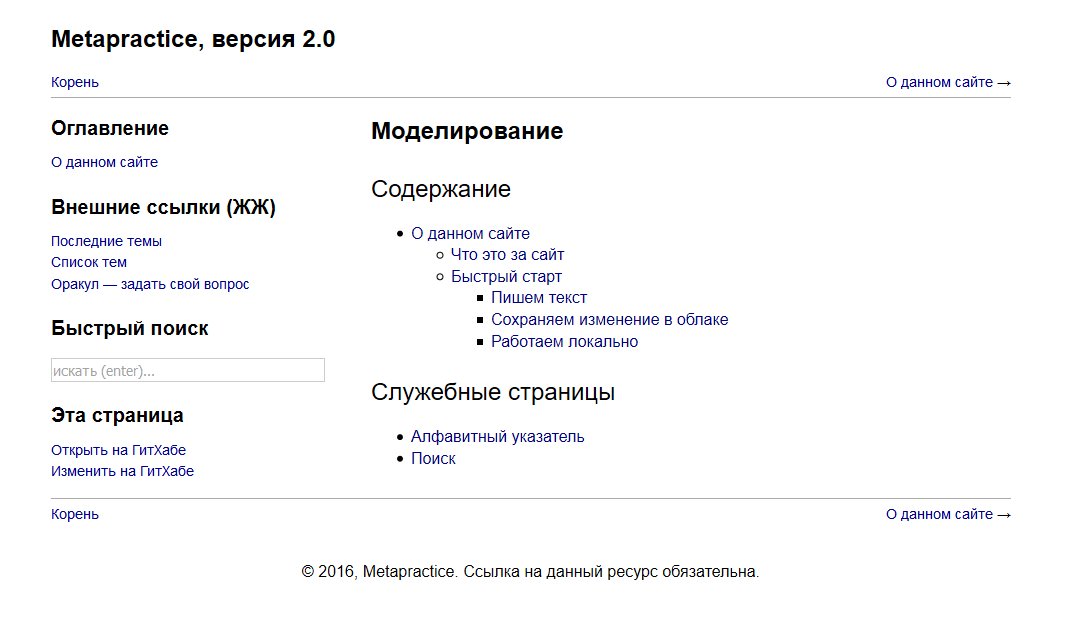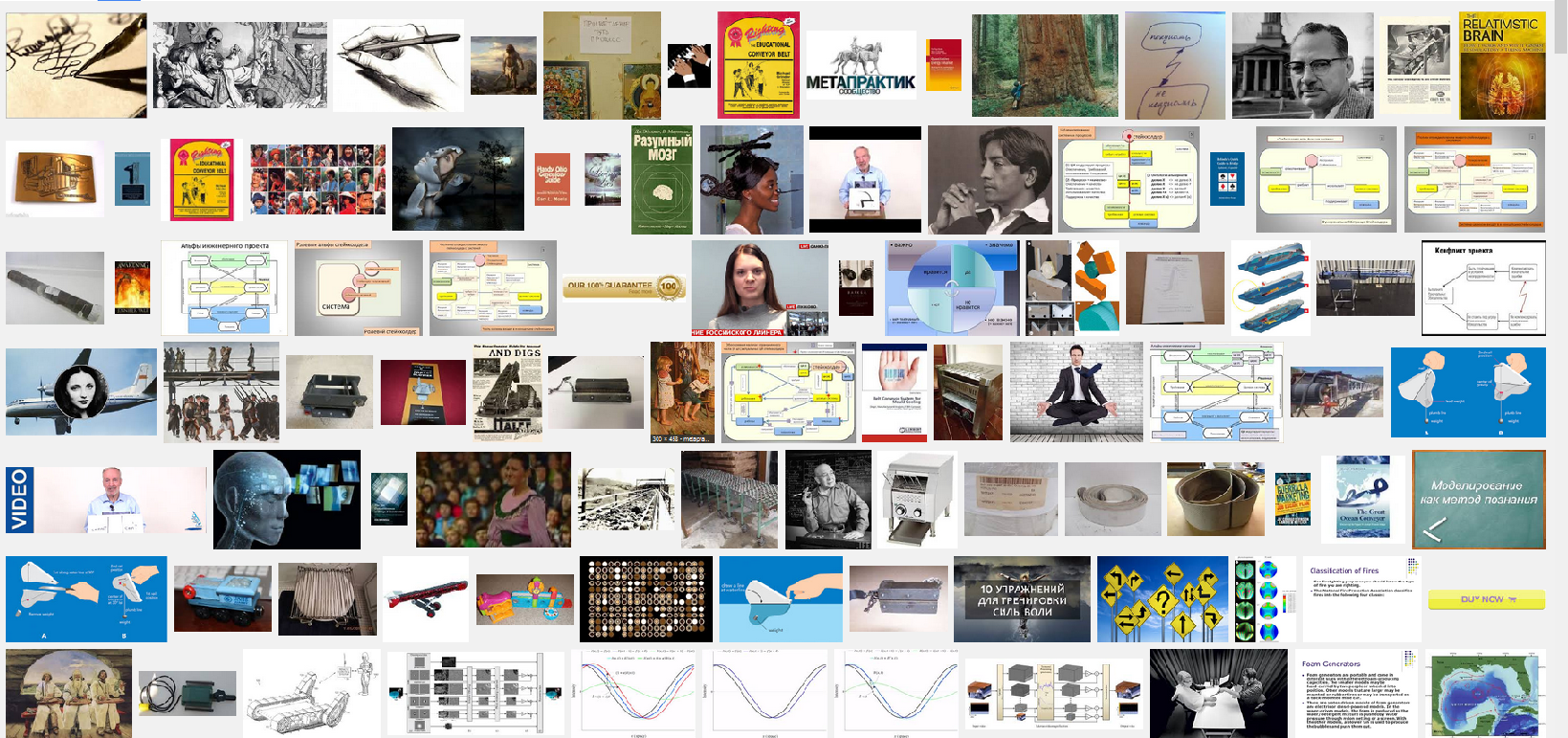Показаны записи 4191 - 4200 из 30984
Да, суровые формы для программеров.
Слушай, а чего мы переживаем? Мы же это уже обсуждали. Ты предлагаешь проект коллективной редакции текстов. Ну, так и работайте себе свободно. В таком раскладе, скорее всего, ты будешь ведущим писателем. И у тебя будет бригада помощников.
Уже возникал в обсуждении формат, в котором вовсе не я главный писатель.
Слушай, а чего мы переживаем? Мы же это уже обсуждали. Ты предлагаешь проект коллективной редакции текстов. Ну, так и работайте себе свободно. В таком раскладе, скорее всего, ты будешь ведущим писателем. И у тебя будет бригада помощников.
Уже возникал в обсуждении формат, в котором вовсе не я главный писатель.
Ну да.
http://metapractice.livejournal.com/491416.html

http://metapractice.readthedocs.io/ru/latest/
Righting the Modeling Conveyor Belt (8) Книга по Метапрактике
http://metapractice.livejournal.com/440177.html


http://metapractice.readthedocs.io/ru/latest/
Righting the Modeling Conveyor Belt (8) Книга по Метапрактике
http://metapractice.livejournal.com/440177.html

Это несомненно.
--Но, уйдёт чёртова куча времени на переделку привычки генерировать текст, сильно отличающийся от конечной формы. Текст с разметкой.
--Мне кажется, вы излишне пугаетесь разметки reStructuredText :) Служебная разметка целенаправлено сведена к минимуму.
Я не пугаюсь. Я ПИШУ ПО-ДРУГОМУ. Манипуляция с вордом встроена в процесс придумывания текста.
Я вполне могу научится придумывать текст вместе с разметкой.
За достаточное дополнительное время.
--Это надо будет специально учиться.
А сколько из наших будут тратить время на учебу?
--Так ли уж сложно? Да вы до регистрации в ЖЖ ведь, как и все мы, писали таким образом тексты на форумах, когда не было никакой специальной разметки.
В клиентах жж есть редакторы. Формат генерации текстов для жж – это очень короткие тексты.
Ну, а если взять вопрос разметки языкоидов. Вот, взять служебную страницу:
http://metapractice.readthedocs.io/ru/latest/technical/site.html
Уже вырисовывается потенциал чуть ли не десяток совершенно естественных маркеров превратить в языкоиды:
— заголовки
— синие гиперссылки
— скобки
— кавычки
— структура предложений и абзацев
— не использовался курсив, но можно использовать
— не использовался жирный шрифт, но можно использовать
— не использовались врезки — можно сделать три-четыре типа разных
— не использовались сноски
— и т.д. и т.п.
Несомненно.
Да и вспомнить книги БиГов. Там Стив ведь не использовал ведь никаких разноцветных и разношёрстных шрифтов. Ну т.е. мне не понятно, как этот аргумент оказался привлечён к дискуссии.
Это не аргумент для дискуссии о возможности научиться разметке.
Это аргумент о интериоризации, которая закодировала мои мозги.
--Мне кажется, вы излишне пугаетесь разметки reStructuredText :) Служебная разметка целенаправлено сведена к минимуму.
Я не пугаюсь. Я ПИШУ ПО-ДРУГОМУ. Манипуляция с вордом встроена в процесс придумывания текста.
Я вполне могу научится придумывать текст вместе с разметкой.
За достаточное дополнительное время.
--Это надо будет специально учиться.
А сколько из наших будут тратить время на учебу?
--Так ли уж сложно? Да вы до регистрации в ЖЖ ведь, как и все мы, писали таким образом тексты на форумах, когда не было никакой специальной разметки.
В клиентах жж есть редакторы. Формат генерации текстов для жж – это очень короткие тексты.
Ну, а если взять вопрос разметки языкоидов. Вот, взять служебную страницу:
http://metapractice.readthedocs.io/ru/latest/technical/site.html
Уже вырисовывается потенциал чуть ли не десяток совершенно естественных маркеров превратить в языкоиды:
— заголовки
— синие гиперссылки
— скобки
— кавычки
— структура предложений и абзацев
— не использовался курсив, но можно использовать
— не использовался жирный шрифт, но можно использовать
— не использовались врезки — можно сделать три-четыре типа разных
— не использовались сноски
— и т.д. и т.п.
Несомненно.
Да и вспомнить книги БиГов. Там Стив ведь не использовал ведь никаких разноцветных и разношёрстных шрифтов. Ну т.е. мне не понятно, как этот аргумент оказался привлечён к дискуссии.
Это не аргумент для дискуссии о возможности научиться разметке.
Это аргумент о интериоризации, которая закодировала мои мозги.
Ну да. В ворде это черновик целого, который потом может подвергнуться редукции в разметке.
Но, методы разметки этого вордовского черновика чисто правополушарные.
А в предлагаемом проекте требуется задействовать левополушарную разметку черновика.
Это радикальные противоположности.
Но, методы разметки этого вордовского черновика чисто правополушарные.
А в предлагаемом проекте требуется задействовать левополушарную разметку черновика.
Это радикальные противоположности.
Понимаешь. Я совсем не так пишу.
Я делаю в ворде разметку текста в целом/ в частях. Причем, где-то это структура заголовков. Где-то фрагменты текста, вставляются сразу на место. А где-то пусто, но есть ассоциации.
И т.п.
Понятно, что для такой работы наличие дополнительной разметки недопустимо. Ну, максимум, значок разметки абзацев временно включить.
И я использую дополнительные разметки цветом, шрифтом и т.п., и т.д.
Я делаю в ворде разметку текста в целом/ в частях. Причем, где-то это структура заголовков. Где-то фрагменты текста, вставляются сразу на место. А где-то пусто, но есть ассоциации.
И т.п.
Понятно, что для такой работы наличие дополнительной разметки недопустимо. Ну, максимум, значок разметки абзацев временно включить.
И я использую дополнительные разметки цветом, шрифтом и т.п., и т.д.
Да я всё понимаю, что разметка есть.
Но, уйдёт чёртова куча времени на переделку привычки генерировать текст, сильно отличающийся от конечной формы. Текст с разметкой.
Эх.
Это надо будет специально учиться.
А сколько из наших будут тратить время на учебу?
Но, уйдёт чёртова куча времени на переделку привычки генерировать текст, сильно отличающийся от конечной формы. Текст с разметкой.
Эх.
Это надо будет специально учиться.
А сколько из наших будут тратить время на учебу?
Ну pdf выглядит убедительно.
Но, это финальная форма.
А как писать прямо в этой форме? Т.е. я пока не представляю как писать черновик, который так сильно отличается от финального текста.
Но, это финальная форма.
А как писать прямо в этой форме? Т.е. я пока не представляю как писать черновик, который так сильно отличается от финального текста.
Ну, примерно представил процесс. Пока очень предварительно.
Ну, общее впечатление. Это инструмент, который сосредоточивает на каких-то мелких фрагментах текста/кода.
И за этим инструментом я текста в целом/ в больших частях не вижу. Типа как в ворде всё время открытая навигация по тексту слева.
Ну, общее впечатление. Это инструмент, который сосредоточивает на каких-то мелких фрагментах текста/кода.
И за этим инструментом я текста в целом/ в больших частях не вижу. Типа как в ворде всё время открытая навигация по тексту слева.
Дочитали до конца.